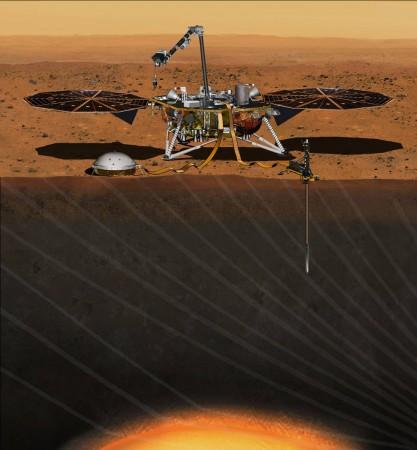
NASA has a Mars mission that is set to launch in about a month from now where it will, for the first time look inside the planet, called the InSight, it will be the first time that humans get a look inside the planet. So far all Mars missions have only studied the surface with rovers and atmosphere using orbiters. InSight will look down into the ground.
The inner composition of the red planet is still completely unknown. "We've got a black hole that starts 5 meters below the surface and goes all the way down to the center," says Bruce Banerdt, InSight's principal investigator and a geophysicist with NASA's Jet Propulsion Laboratory (JPL), reports ScienceMag. The InSight's mission is to measure thickness and composition of Mars' crust, mantle, and core.
Data collected by InSight will pave the way for better understanding of how Mars lost its magnetic field and if the planet once had plate tectonics –a crust made of large plates that glide over the inner mantle. The lander will also have a seismograph to measure marsquakes, notes the report.
The InSight mission was actually planned to be launched two years back, notes the report. A leak was found in the seismometer's vacuum, almost forced the cancellation of the project, but after years of work, a fix was found and the project is back on track. The InSight mission also marks the return of NASA to planetary seismology after nearly 40 years. The last time was when Apollo astronauts delivered five seismographs to the Moon where lunar quakes helped identify the internal makeup of the satellite.
InSight is based on the same platform as 2008's Phoenix lander, notes the report. Built by JPL in collaboration with Lockheed Martin and other European partners, it is set to land on what Banerdt says is, "the most geologically boring site on the planet". A smooth lava plain near the Martian Equator is where InSight will land, using parachutes and retrorockets to safely reach the surface. While InSight could work just as well in pretty much any spot on the planet, a boring, smooth, tropical place was chosen because there are little to no landing hazards in this location, and there is also enough sunlight to keep the solar panels active.
InSight's seismograph will be about the size of a volleyball, notes the report. There will also be a heat probe that will be driven 5 meters into the ground. A robotic arm equipped with a tungsten hammer will plant it deep into the surface of Mars with thousands of strikes.
The lander is expected to reach Mars and begin work by November.















